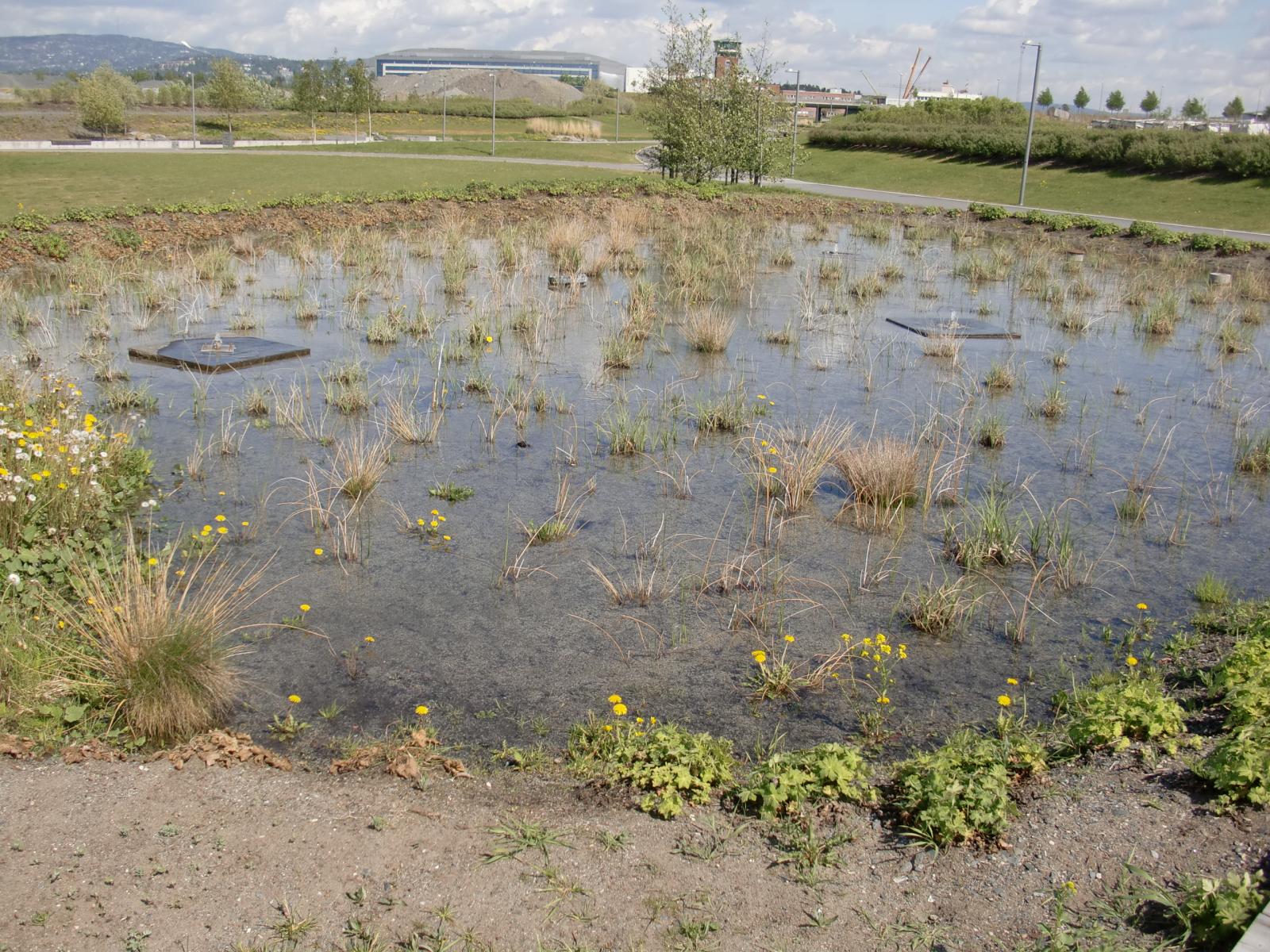Last updated: October 2021
Fornebu used to be Norway’s main airport, but was abandoned in 1998. The Fornebu project aimed to restore the 340 ha site in order to provide a sustainable, multi-use built environment with sustainable drainage systems and other green infrastructure in focus. The site now consists of residential and industrial buildings with a focus on green space and natural storm water management, involving the use of open and natural water retention methods, including swales, filter strips, permeable surfaces, detention basins and retention ponds (Ref. 1).
Overview
Nature-based solution
- Parks and urban forests
- Pocket parks/neighbourhood green spaces
- Green corridors and green belts
- Blue infrastructure
- Lakes/ponds
- Green areas for water management
- Rain gardens
- Swales and filter strips
- Sustainable urban drainage systems
Key challenges
- Water management (SDG 6)
- Flood protection
- Stormwater and rainfall management and storage
- Improvements to water quality
- Green space, habitats and biodiversity (SDG 15)
- Green space creation and/or management
- Regeneration, land-use and urban development
- Promote natural styles of landscape design for urban development
- Health and well-being (SDG 3)
- Creation of opportunities for recreation
- Economic development and employment (SDG 8)
- Real estate development
Focus
Creation of new green areas, Creation of semi-natural blue areas, Transformation of previously derelict areas
Project objectives
The goals of the NBS were:
- Utilization of stormwater and green areas as a resource to increase well-being, recreational value, biodiversity and property value
- Satisfactory water balance in the Storøyilen nature reserve
- Minimization of contaminant discharge from stormwater to meet the water quality targets determined for green areas, the central dam and the conservation area (coastal zone)
- Safety against flood damage
- Higher cost effectiveness compared to traditional systems
(Ref. 1)
Implementation activities
Creation of retention ponds, detention basins, swales, filter strips, canals and permeable surfaces for flood prevention as increased level of rainfall is expected due to climate change (Ref. 3).
Main beneficiaries
- National-level government
- Local government/Municipality
- Citizens or community groups
Governance
Management set-up
- Government-led
Type of initiating organisation
- National government
- Local government/municipality
Participatory approaches/ community involvement
- Citizen monitoring and review
Details on the roles of the organisations involved in the project
National Government: Statsbygg (Norwegian Directorate of Public Construction and Property), as primary land owner & financier with primary responsibility for design and implementation of NBS (Ref. 3)
Local Government: City of Oslo, as secondary landowner; Municipality of Bearun, bears responsibility for infrastructure and green space (Ref. 3)
Private Sector: Bjørbekk & Lindheim AS - Landscape architect (Ref. 2)
Researchers/ Universities: Interconsult ASA & Aalborg University – released research publication on Fornebu (Ref. 4)
Citizens: The Municipal Plan of Bærum (part 2) was available for public review in March and April 1999 (Ref. 5)
Project implemented in response to ...
... an EU policy or strategy?
No
("The Fornebu development was motivated primarily by national as opposed to European priorities" (Ref. 3))
... a national policy or strategy?
Yes
(The Norwegian governments commitment to environmental sustainability as well as stormwater overflows (Ref. 3) )
... a local policy or strategy?
Yes
(The Municipal Plan for the Fornebu Area (1999) (Ref. 5))
Financing
Total cost
€500,000 - €2,000,000
Source(s) of funding
- Public national budget
Type of funding
- Earmarked public budget
Non-financial contribution
Unknown
Impacts and Monitoring
Environmental impacts
- Water management and blue areas
- Improved water quality
- Increased protection against flooding
- Improved stormwater management
- Green space and habitat
- Promotion of naturalistic styles of landscape design for urban development
- Increased green space area
Economic impacts
- Stimulate development in deprived areas
Socio-cultural impacts
- Health and wellbeing
- Gain in activities for recreation and exercise
Type of reported impacts
Expected impacts, Achieved impacts
Presence of formal monitoring system
Yes
Presence of indicators used in reporting
Yes
Presence of monitoring/ evaluation reports
Yes
Availability of a web-based monitoring tool
No evidence in public records
References
1. Statsbygg, (2004). Open Stormwater Solutions, Experiences and Recommendations/Åpne overvannsløsninger, erfaringer og anbefalinger. Statsbygg 04/2004. [Document provided].
2. Norske Arkitekters Lanskapsforbund (2011). Fornebu - Stormwater Management/Fornebu - Overvannshåntering. Available at: Source link [Accessed: 29 October 2020].
3. European Commission (2013). Natural Water Retention Measures. Fornebu Case Study. [Document provided].
4. Åstebøl, S., Hvitved-Jacobsen, T. and Simonsen, Ø. (2004). Sustainable stormwater management at Fornebu—from an airport to an industrial and residential area of the city of Oslo, Norway. Science of The Total Environment, 334-335, Source link. [Document provided].
5. Bærum Municipality (1999). Municipal Plan for the Fornebu Area. 19.04.99/Kommunedelplan 2 For Fornebu-området Høringsdokument 19.04.99. [Document provided].
6. The City of Oslo (2017). Quiet Urban Areas. [Not available in 2020].
7. Bærum Municipality (2016). Program plan for Fornebu - revision of the Municipal Plan part 2/Planprogram for Fornebu – revisjon av kommunedelplan 2. [Document provided].
2. Norske Arkitekters Lanskapsforbund (2011). Fornebu - Stormwater Management/Fornebu - Overvannshåntering. Available at: Source link [Accessed: 29 October 2020].
3. European Commission (2013). Natural Water Retention Measures. Fornebu Case Study. [Document provided].
4. Åstebøl, S., Hvitved-Jacobsen, T. and Simonsen, Ø. (2004). Sustainable stormwater management at Fornebu—from an airport to an industrial and residential area of the city of Oslo, Norway. Science of The Total Environment, 334-335, Source link. [Document provided].
5. Bærum Municipality (1999). Municipal Plan for the Fornebu Area. 19.04.99/Kommunedelplan 2 For Fornebu-området Høringsdokument 19.04.99. [Document provided].
6. The City of Oslo (2017). Quiet Urban Areas. [Not available in 2020].
7. Bærum Municipality (2016). Program plan for Fornebu - revision of the Municipal Plan part 2/Planprogram for Fornebu – revisjon av kommunedelplan 2. [Document provided].

